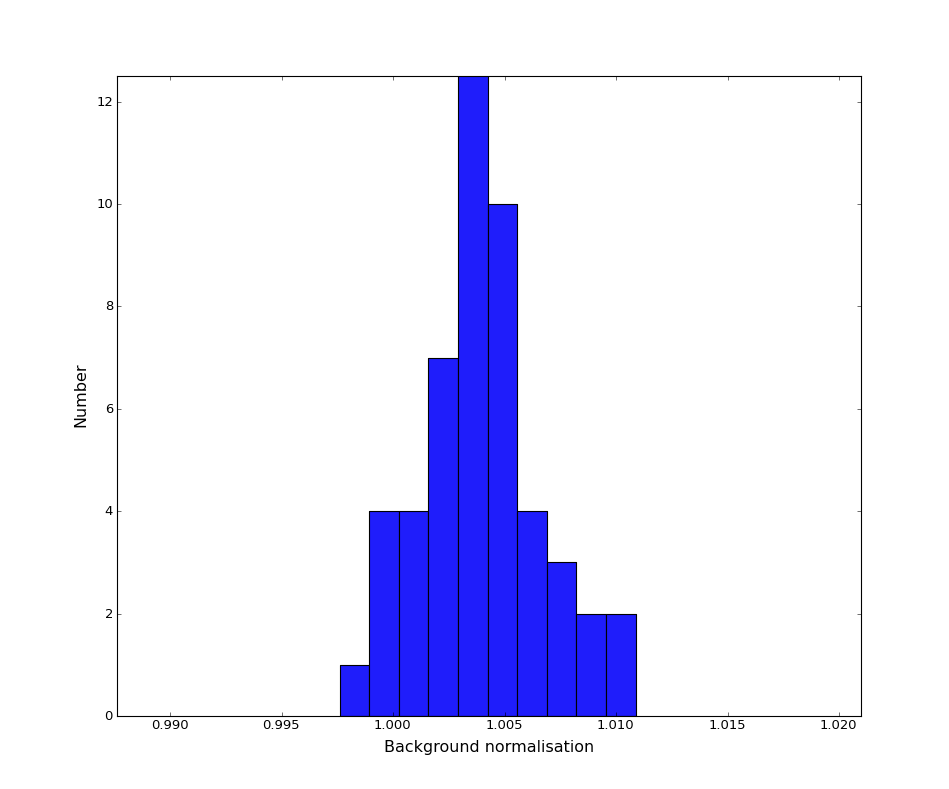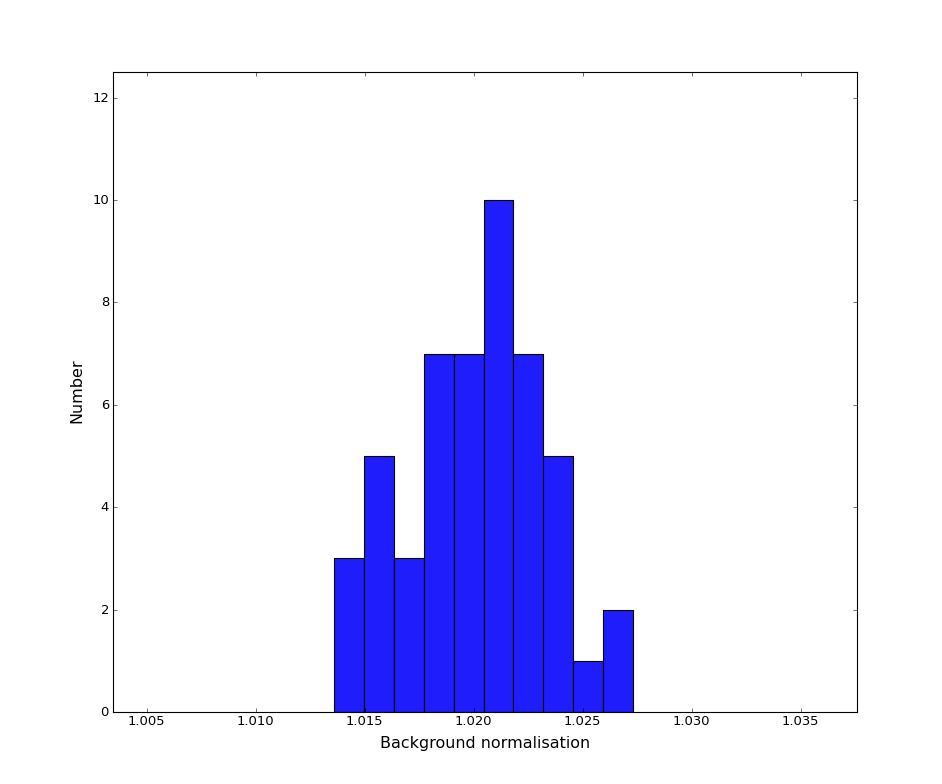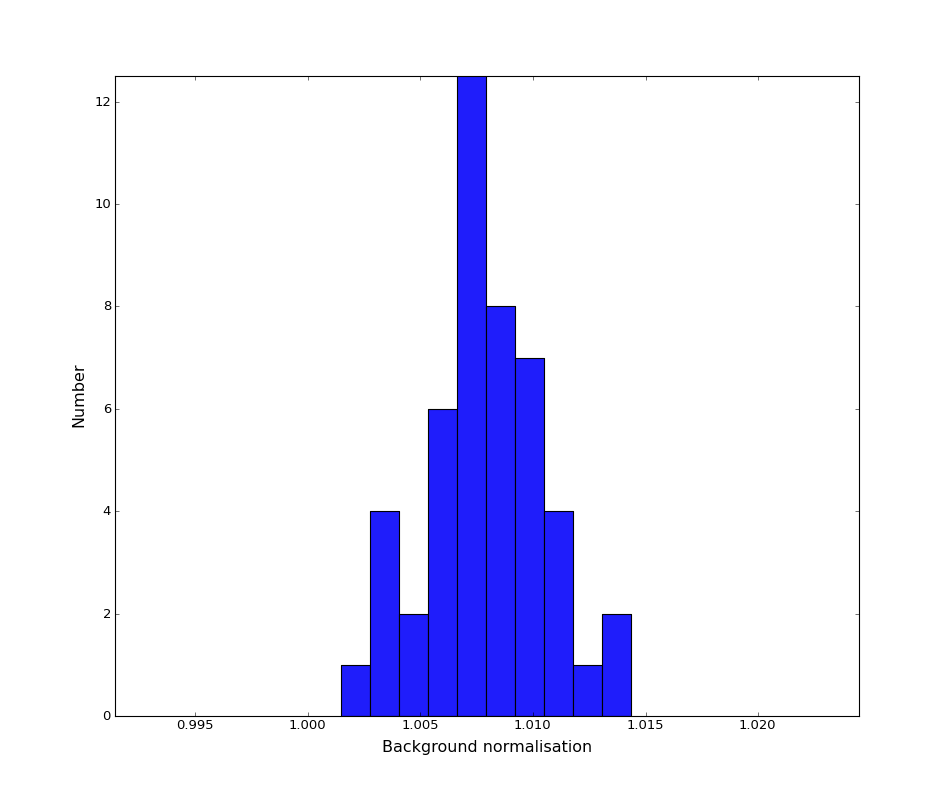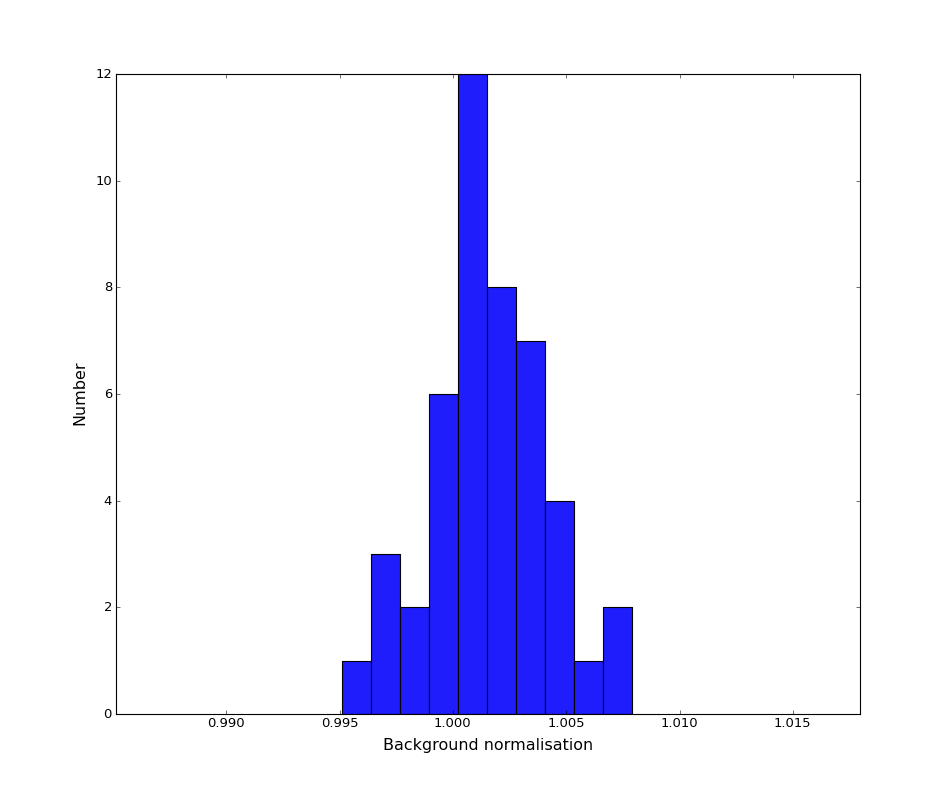Bug #1151
Level of fitted background
| Status: | Closed | Start date: | 02/24/2014 | |
|---|---|---|---|---|
| Priority: | Normal | Due date: | ||
| Assigned To: | % Done: | 100% | ||
| Category: | - | |||
| Target version: | - | |||
| Duration: |
Description
When using a GCTAModelInstBackground in an analysis of a single point source, it looks like the background if not fitted at the right normalization (which I expected to be 1). The level is something like 1.02-1.03, which is significantly above the statistical fluctuations (I always got it >1 anyway, never something like 0.99). It may be connected to another issue that arises when using a ROI radius of 5deg, which is the same size as the radius over which the background is defined. Then, the fit is not accurate, with delta between observed and predicted counts of several 1000.
Attached is the log of two runs: one with a ROI size of 4deg (top of the file) and one with a ROI of 5deg (bottom of the file).
Recurrence
No recurrence.
Related issues
History
#1
 Updated by Knödlseder Jürgen almost 11 years ago
Updated by Knödlseder Jürgen almost 11 years ago
I see that you have set the pivot energy to 1 MeV. Although the index is fixed to 0, I’m wondering whether this can lead to some numerical problems. Can you set the pivot to the TeV domain, or better use a simple spectral constant for the normalization?
#2
 Updated by Martin Pierrick over 10 years ago
Updated by Martin Pierrick over 10 years ago
- Assigned To changed from Knödlseder Jürgen to Martin Pierrick
#3
 Updated by Martin Pierrick over 10 years ago
Updated by Martin Pierrick over 10 years ago
- Status changed from New to Resolved
- Assigned To changed from Martin Pierrick to Knödlseder Jürgen
- % Done changed from 0 to 90
I did some additional tests:
- One pointing of 10,50,100h
- One point source in the field
- Unbinned analysis over 1-10TeV, also tried 100GeV-10TeV and 1-100TeV
- IRF .../data/cta/aar/bcf/DESY20140105_50h/irf_file.fits
- 50 fits in each case
- code version devel/bd092b9
Results are (model 1 is the point source):
True parameters (first background, then point source): [1.0, 0.0, 8.2e-19, -2.8]
100GeV-10TeV / 50h
Mean/deviation of background normalisation: 9.999464e-01 (9.115832e-04)
Mean/deviation of background index: 0.000000 (0.000000)
Mean/deviation of model 1 normalisation: 8.178346e-19 (1.263012e-20)
Mean/deviation of model 1 index: -2.801564 (0.011369)
1-100TeV / 50h
Mean/deviation of background normalisation: 1.000739e+00 (4.738377e-03)
Mean/deviation of background index: 0.000000 (0.000000)
Mean/deviation of model 1 normalisation: 8.105815e-19 (2.989788e-20)
Mean/deviation of model 1 index: -2.789380 (0.038785)
1-10TeV / 50h
Mean/deviation of background normalisation: 1.001022e+00 (4.984124e-03)
Mean/deviation of background index: 0.000000 (0.000000)
Mean/deviation of model 1 normalisation: 8.163553e-19 (3.259923e-20)
Mean/deviation of model 1 index: -2.800814 (0.046734)
I don’t see the problem anymore. There is no impact pivot energy of the background (1MeV or 1TeV, this is not used anyway). Not sure about what changed in the code since when I reported the problem. The mean parameters of the point source converges towards the true values if I increase the observing time:
1-10TeV / 100h
Mean/deviation of background normalisation: 1.000153e+00 (2.728596e-03)
Mean/deviation of background index: 0.000000 (0.000000)
Mean/deviation of model 1 normalisation: 8.201161e-19 (2.412416e-20)
Mean/deviation of model 1 index: -2.806473 (0.036199)
So overall, it looks like it is OK. I have not done more test than that but the case can probably be closed.
#4
 Updated by Martin Pierrick over 10 years ago
Updated by Martin Pierrick over 10 years ago
- File Unbinned_fits_50h.png added
- File Binned_fits_50h.png added
- File Binned_file_50h.png added
- Status changed from Resolved to In Progress
- Assigned To changed from Knödlseder Jürgen to Martin Pierrick
- % Done changed from 90 to 10
FORGET ABOUT THE PREVIOUS POST !
There must have been something wrong in the previous tests and I probably tested GCTAModelRadialAcceptance with ASCII IRF definition instead of GCTAModelInstBackground with FITS definition. With appropriate tests, I confirm there is an offset.
The setup now is:
- One pointing of 50h
- No source in the field
- Unbinned analysis over 1-10TeV
- ... also tried binned with 5 bins
- IRF .../data/cta/aar/bcf/DESY20140105_50h/irf_file.fits
- 50 fits in each case
- code version devel/bd092b9
The output is :
Mean/deviation of background normalisation: 1.004012e+00 (2.674310e-03)
... and the distribution of the 50 runs is shown in Unbinned_fits_50h.png
The situation is even worse for a binned analysis:
Mean/deviation of background normalisation: 1.020184e+00 (3.195677e-03)
... and the distribution also is worse, see Binned_fits_50h.png
Comparing that to other ways to set up the background:
- A gaussian for radial dependance and a power-law for spectrum: works perfectly for both binned and unbinned (tested only 50h)
- A gaussian for radial dependance and an ASCII file for spectrum: works for unbinned but not for binned (tested only 5 bins)
For the latter case, see plot Binned_file_50h.png
More testes needed...
#5
 Updated by Martin Pierrick over 10 years ago
Updated by Martin Pierrick over 10 years ago
- File Binned_file_50h_12bins.png added
- Status changed from In Progress to Resolved
- Assigned To changed from Martin Pierrick to Knödlseder Jürgen
- Priority changed from High to Normal
- % Done changed from 10 to 90
Following up on that...
The test of background normalization when using a gaussian for radial dependance and an ASCII file for spectrum turns out to work well provided there are enough energy bins (something like 10-12 at least). See plot Binned_file_50h_12bins.png.
The problem of background normalisation when using GCTAModelInstBackground with the current set of instrument performances remains. It is most likely due to the coarse spatial binning of these responses, which leads to problems because the events simulation and the model-fitting handle this background differently: the former uses a cumulative distribution function, which has steps, while the latter uses an interpolation. When bins are too large, it is not surprising that the same number of counts is not obtained because there is no reason for it. A possible solution would be to finely rebin the background spatial distribution using the same function that is used for interpolation in model-fitting. Or wait for more accurate performance files.
#6
 Updated by Knödlseder Jürgen over 10 years ago
Updated by Knödlseder Jürgen over 10 years ago
- Status changed from Resolved to In Progress
Put this back into “In Progress” as Stefan Ohm was also stumbling over this in his simulations of Arp220. We should really find a fix for this.
#7
 Updated by Knödlseder Jürgen over 10 years ago
Updated by Knödlseder Jürgen over 10 years ago
- File simArp220.py
 added
added
Attached Stefan’s script that nicely produced the problem: simArp220.py
#8
 Updated by Knödlseder Jürgen over 10 years ago
Updated by Knödlseder Jürgen over 10 years ago
Stefan wrote:
Dear Juergen,
thanks for looking into this. I can confirm your numbers for the IFAE response files when leaving all parameters free. Indeed the > background normalisation is ~0.9 ± 0.001 in this case. For the DESY/aar responses, however, we are off by a significant number (norm 1.35 ± 0.08, index -2.72 ± 0.05, background 0.82 ± 0.001).
Just let me know if I can help with testing.
Cheers, Stefan
I could confirm these values. One of the differences is the resolution of the background file. For DESY it is 14*14*21 bins (in DETX, DETY, energy) for IFAE it is 32*32*20 bins. The actual code makes a difference between Monte Carlo simulations (which spatially distributes the events evenly within a bin) while the model interpolates smoothly. Thus with a coarse spatial binning the situation will get worse.
One way to circumvent the problem would be to spatially rebin the background maps before using them. Implementation of feature #1212 would be needed for this.
#9
 Updated by Knödlseder Jürgen over 10 years ago
Updated by Knödlseder Jürgen over 10 years ago
- File Arp220-simulations.xlsx added
I recognized that the GCTAModelBackground constructor has optional parameters that allow for a rebinning. By default these parameters are 0, but you may add nx, ny, nenergies to the constructor to get a finer internal pixelisation of the background model, e.g.
bck = gl.GCTAModelBackground(ob,filename,spec,100,100,100)
I did a couple of tests and come close to the true values. Higher resolution in nx and ny improves the source parameters, higher resolution in nenergies the background model parameters (see attached excel file).
#10
 Updated by Knödlseder Jürgen over 10 years ago
Updated by Knödlseder Jürgen over 10 years ago
I also recognized that Stefan uses GCTAModelBackground while in the future GCTAModelInstBackground should be used that fetches directly the response from the IRF file. I still need to look how rebinning can be implemented for that case.
#11
 Updated by Knödlseder Jürgen over 10 years ago
Updated by Knödlseder Jürgen over 10 years ago
- File Arp220-simulations.xlsx added
#12
 Updated by Knödlseder Jürgen over 10 years ago
Updated by Knödlseder Jürgen over 10 years ago
- File deleted (
Arp220-simulations.xlsx)
#13
 Updated by Knödlseder Jürgen over 10 years ago
Updated by Knödlseder Jürgen over 10 years ago
- File simArp220_new.py
 added
added - File Arp220-10h-simulations.xlsx added
- Status changed from In Progress to Feedback
- % Done changed from 90 to 100
I now implemented an internal rebinning to a finer grid into GCTAModelInstBackground. This gave reasonable results for the Arp220 test case. Attached an excel file and the test script used. Code is in the devel branch.
Please provide feedback and tell me if this also works for you.
#14
 Updated by Knödlseder Jürgen over 10 years ago
Updated by Knödlseder Jürgen over 10 years ago
- Status changed from Feedback to Resolved
#15
 Updated by Knödlseder Jürgen over 10 years ago
Updated by Knödlseder Jürgen over 10 years ago
- Status changed from Resolved to Closed



